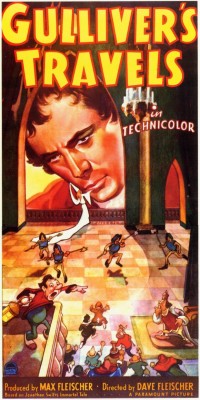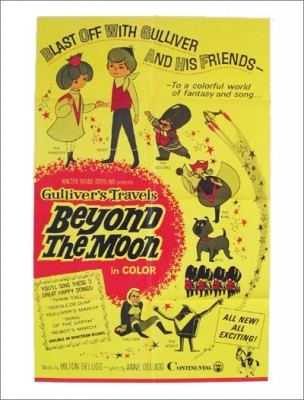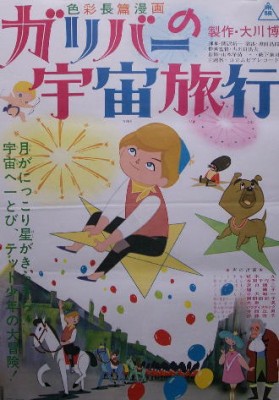| Reviews & Columns |
|
Reviews DVD TV on DVD Blu-ray 4K UHD International DVDs In Theaters Reviews by Studio Video Games Features Collector Series DVDs Easter Egg Database Interviews DVD Talk Radio Feature Articles Columns Anime Talk DVD Savant Horror DVDs The M.O.D. Squad Art House HD Talk Silent DVD
|
DVD Talk Forum |
|
|
| Resources |
|
DVD Price Search Customer Service #'s RCE Info Links |
|
Columns
|
|
|
Ultimate Gulliver Collection (Gulliver's Travels [1939] / Gulliver's Travels Beyond the Moon), An
In any case like most public domain releases, caveat emptor. Video/audio quality varies from (suspiciously) excellent to extremely poor, though overall this set shows more care than usual and for a PD release is above average. Included is Max & Dave Fleischer's Gulliver's Travels (1939), which was just the second animated feature ever made; an Americanized Japanese animated feature, Gulliver's Travels Beyond the Moon (Garibā no Uchū Ryokō, 1965); a hand-tinted Georges Méliès silent short, Gulliver's Travels Among the Lilliputians and the Giants (Le Voyage de Gulliver à Lilliput et chez les Géants , 1902); and seven "Gabby" shorts, nearly forgotten one-reel cartoon spin-offs from the Fleischers' Gulliver.
The 1939 Gulliver's Travels has already been released to Blu-ray (in 2009 by E1 Entertainment), yet in at least one respect this PD release is superior. The Blu-ray version was needlessly stretched and reformatted to fit widescreen TVs while this transfer, though hardly anything to crow about, is full-frame and at least watchable.
Spurred by the huge and unanticipated success of Disney's Snow White and the Seven Dwarfs (1937), an RKO release, Max & Dave Fleischer's distributor, Paramount, green-lighted the production a feature film, an enormous undertaking necessitating the building of a bigger studio; perversely, the Fleischers chose to leave their New York-based operations for a new complex in Miami, Florida - a decision that expedited their company's ultimate downfall.
Unlike Disney, who lavished money and time cultivating his animators and spent nearly four years making Snow White, the Fleischers had less than two years for Gulliver, and were forced to staff their production with whomever they could get. They hired away qualified animators from other studios, but also engaged local artists of dubious talent for the more mundane tasks. The West Coast-based animators didn't get along with the Fleischer animators from New York, and neither faction got along with the local talent. Even Max and Dave were feuding.
The resultant film loosely follows only the Lilliputian adventures of Gulliver (voiced by Sam Parker). Film and TV adaptations rarely get beyond Brobdingnag, Gulliver's second voyage, and almost never attempt to adapt his trips to Laputa, Japan, and the Country of the Houyhnhnms. (Nor Balnibarbi, Luggnagg, or Glubbdubdrib.) Seafarer Lemuel Gulliver is shipwrecked, washed up on the shores of Lilliput, a kingdom inhabited by tiny people the size of mice. Town crier Gabby (Pinto Colvig, also the voice of Disney's Goofy) discovers the unconscious Gulliver, but King Little (Jack Mercer, Popeye's longtime voice) is too busy arranging the marriage of his daughter, Princess Glory (Jessica Dragonette) to Prince David (Lanny Ross) of Blefuscu. However, that country's King Bombo wants "Forever" sung at the wedding ceremony while King Little insists on Lilliput's national folk song, "Faithful." Unyielding, Bombo declares war.
When Gabby finally gets a word in about the giant Gulliver, the citizenry of Lilliput is in an uproar, but the amused, amazing colossal man soon declares his peaceful intentions and even defends Lilliput against Bombo's naval assault.
The film is alternately innovative and, at times, almost primitive compared to the huge creative leaps made by Disney with Snow White. In contrast to the very cartoony Lilliputians (except for the prince and princess, who in terms of design are more in keeping with Snow White and Prince Charming), Gulliver is animated as was realistically possible in 1938-39, via the process of rotoscoping. Actor Sam Parker was filmed and his movements traced and inked-in frame-by-frame. Though Gulliver's facial features never look real, his movements are vividly authentic and the imaginative "lighting" of these scenes, such as a long sequence where Gulliver enjoys a nighttime feast with his tiny hosts, is extremely impressive, while the opening storm sequence anticipates in some ways animation later found in Disney's Pinocchio (1940). Oddly, the Fleischers' unique and often visually stunning three-dimensional process - standard animation photographed over 3-D models, often animated on a rotating, drum-like base - wasn't employed for this film except, sort of, the opening titles, which utilizes a model of Gulliver's ship.
But, except for Gulliver, who pretty much stands around looking amused (often saying, "My, my!"), the story and characters are animation cel-thin, the sort that populate one-shot one-reel cartoons from earlier in the decade. Gabby, obviously intended as the break-out character, is something like the Fleischer's version of Grumpy from Snow White (coincidentally also voiced by Colvig), with a dash of Donald Duck's irascibleness, but he's charmless and the film has none of the emotional impact of Snow White. It's colorful and moderately entertaining, but lacks the heart of Disney's film, and even more urgently has none of the Fleischers' trademark wit that make the Betty Boop and Popeye cartoons of the 1930s some of the best shorts ever done. (That said, my three-year-old daughter enjoyed Gulliver's Travels enormously, much to my surprise.)
Gulliver's Travels Beyond the Moon is a fairly typical example of Japanese feature animation of the 1960s: the lower budgets and less-fluid movements are compensated by striking designs and storytelling concepts and characterizations unsullied by the Disney influence. For years this decidedly Asian approach was dismissed as merely cheap and shoddy, partly because when these films were distributed in America they were often radically altered if not ruined in the process. That seems at least partly the case here.
The movie opens cleverly, with scenes of Gulliver and his ship at sea closely patterned after the Max & Dave Fleischer film, which is soon revealed to be a movie-within-the-movie, which homeless boy Ricky has snuck into a cinema to see. Later he meets the still-alive Gulliver (now an old man), who invites Ricky to join his outer space expedition, along with a talking bulldog and toy soldier, and Gulliver's assistant, a crow named (in the American version) Sylvester.
The two versions include strange jumbles of talent. In Japan this appears to have been a fairly major production, as its voice cast includes Kyu Sakamoto (best known in the U.S. for the song "Sukiyaki") as Ricky. Sakamoto remains one of the two or three biggest pop stars in Japan (he died in a horrific 1985 plane crash that claimed 520 lives), and he was also a major film and television star at the time. Important character actors like Shoichi Ozawa and Seiji Miyaguchi, the latter famous as the master swordsman in Seven Samurai, also lend their talents. The screenplay was by Shinichi Sekizawa, who wrote many of Japan's giant monster movies, while its score was by the prolific Isao Tomita. More importantly for animation buffs, one of the in-between artists was Hayao Miyazaki (My Neighbor Totoro, Ponyo); it was one of his first professional jobs.
The American version jettisoned Tomita's score and replaced it with an appalling one by Milton and Anne Delugg, best-known for their laughable songs for Santa Claus Conquers the Martians (1964). The English voice cast includes former Our Gang member Darla Hood, one of her few acting gigs after the early-1940s.
Unlike Gulliver's Travels, the Japanese film is very badly transferred. For starters, it was filmed in Toeiscope, an anamorphic process akin to CinemaScope and Panavision but which is panned-and-scanned here. The color is poor and the combing is downright headache-inducing, with the entire movie looking like double exposures of adjacent frames, rather like watching a 3-D movie without the glasses. It's clear there's a good film buried in there somewhere, but this presentation only hints at what might have been. Though an 85-minute running time is listed the film runs 77:28. A 16:9 enhanced widescreen version (but without English subtitles) was released by Toei Video to DVD in Japan.
Contrastingly, the charming, typically inventive Gulliver's Travels Among the Lilliputians and the Giants looks more than a little too good; despite some digital artifacting, the transfer is otherwise superb. The print is in fine shape, is hand-colored, and even features an original piano score in full stereo. I'll assume Film Chest, Inc. legitimately licensed this from Flicker Alley - it appears sourced from their release of Georges Méliès: First Wizard of Cinema - I'd imagine the original score is copyrighted at the very least.
Finally, the seven "Gabby" cartoons, all originally in three-strip Technicolor (as was Gulliver's Travels), are well-made but only underscore the character's vacuous personality. Gulliver is nowhere to be found in these shorts, though King Little turns up in one short. That the series is set in Lilliput plays no part and, combined with Gulliver's absence, makes one wonder why these were made at all, except as promotion for the feature film. The quality varies enormously; the first and last look quite good. Those two shorts have the original, unaltered Paramount Pictures openings. The others, ranging from mediocre to poor, are TV prints from National Telefilm Associates (NTA) or U.M.& M. TV Corp., which lop off Paramount's name in the crudest manner possible.
Video & Audio
See above for comments about the video/audio quality, which varies greatly. The disc is region-free and includes no alternate audio or subtitle options. There are no Extra Features beyond the various shorts described above.
Parting Thoughts
This is a cleverly packaged but poorly produced set that exemplifies the pitfalls of films lapsing into the public domain and how in particular this dooms visually sumptuous animated films to undeserved obscurity. For now, An Ultimate (cough, cough) Gulliver's Collection will do as a reference copy, but I hope Paramount (in the case of the Fleischer films) and an enterprising indie label (in the case of the Toei feature) will give these titles the kind of eye-opening presentations they really deserve. Until then, for most, this is a Rent It.
Stuart Galbraith IV's latest audio commentary, for AnimEigo's Musashi Miyamoto DVD boxed set, is on sale now.
|
| Popular Reviews |
| Sponsored Links |
|
|
| Sponsored Links |
|
|
| Release List | Reviews | Shop | Newsletter | Forum | DVD Giveaways | Blu-Ray | Advertise |
|
Copyright 2024 DVDTalk.com All Rights Reserved. Legal Info, Privacy Policy, Terms of Use,
Manage Preferences,
Your Privacy Choices | |||||||


















